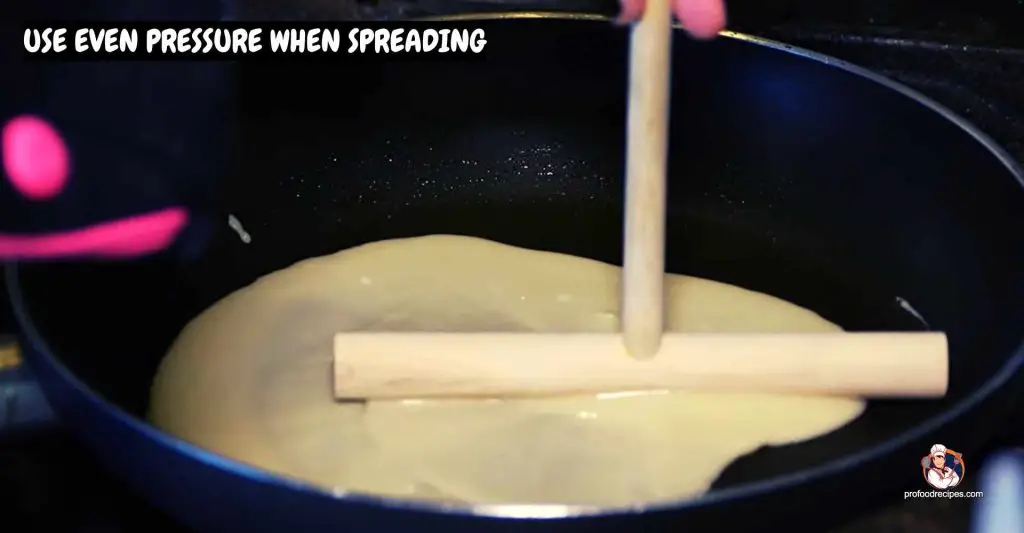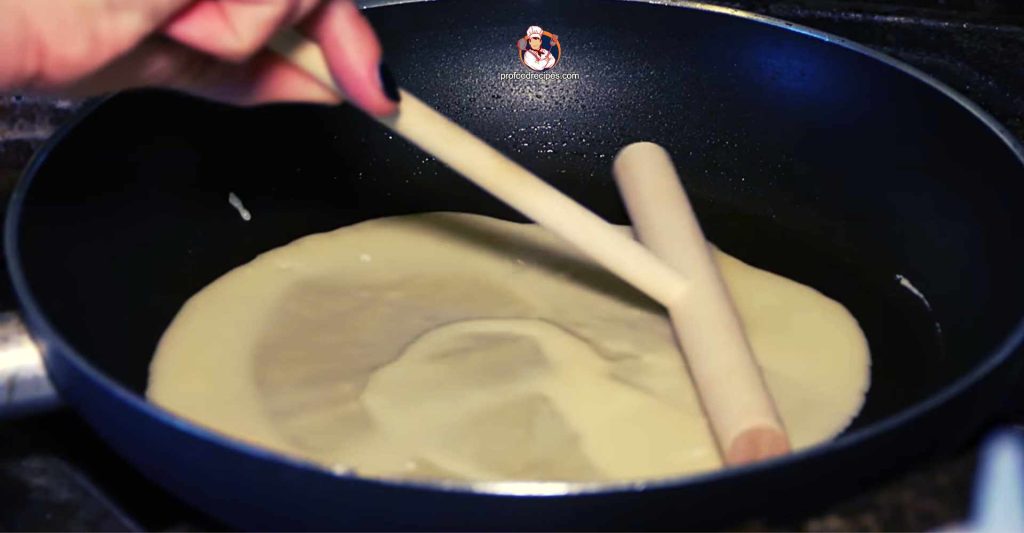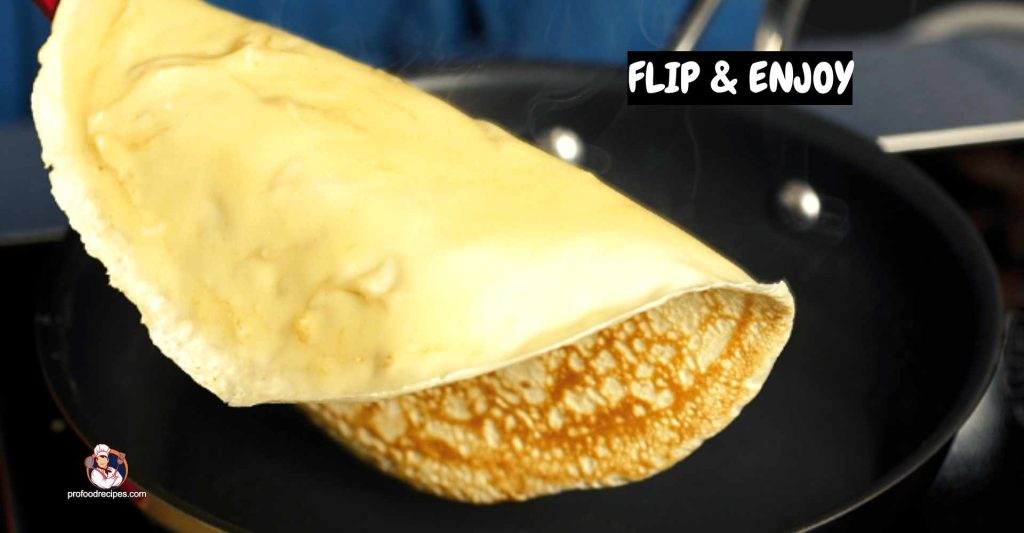Last Updated on February 24, 2023 by Amanda P. Brown
The crepe spreader is a unique kitchen tool that can make delicious crepes in five minutes or less. It’s easy to pick up and use after you have the basic layout.
The batter must be properly distributed around the pan to achieve perfectly thin and golden crepes. The T-shaped batter spreader is the most efficient tool for evenly spreading batter across the whole crepe pan.
However, to achieve professional results when making crepes, see the following article about How to use a crepe spreader?
Is a Crepe Spreader Necessary?
Table of Contents
A crepe spreader is essential to your crepe maker’s plate if you want perfectly round, paper-thin crepes every time. The benefit of a crepe spreader would be that it produces evenly sized, thin, and consistent crepes. Also, the curved handle makes it easier to hold and move around than regular utensils, allowing for better control during production.
If you’re starting, picking up a circular wooden spreader is suggested. Determine the plate’s diameter to determine the appropriate spreader size. The broader the spreader, the larger the plate.
How to Use a Crepe Spreader?

Before you get started, ensure you get the proper size and style of crepe spreader. Since the quantity of batter varies from recipe to recipe, picking the right spreader to distribute your crepe mix uniformly without making the crepes too thin or too thick is essential.
A traditional French-style metal crepe spreader works best with thicker batters, while a silicone version works best with thinner batters.
Now, let’s see the best technique to use a crepe spreader.
1. Warm Your Pan Before Using

Spend some time warming your pan over medium heat for around five minutes before using your crepe spreader. As a result, the surface temperature of the pan can properly transfer heat over every square inch of the cooking surface, ensuring that your delicate crepe won’t cling or move as soon as it touches the pan.
2. Lightly Grease

Depending on the type of cookware used, greasing may be necessary. Keep in mind that nonstick cookware typically calls for very little or no fat, and aim for one teaspoon of oil or butter per inch of pan area.
Be sure to evenly cover the surface by carefully covering every inch before spreading the batter. Bear in mind that an excessive amount of fat might impart an unpleasant greasiness to the final result.
3. Use Even Pressure When Spreading

Hold onto both of the metal version’s handles with a gentle grip as soon as your pan has come into touch with enough heat for proper cooking (about 5 minutes is optimum). On silicone, you can also utilize two finger grooves placed diagonally from one another.
Then firmly apply constant pressure across every portion of its surface area until the desired thickness has been achieved. It’s best not to extend beyond these edges but rather remain within their confines for an elegant and uniform presentation in a finished form!

4. Dip Your Spreader in Cold Water

If unused batter begins sticking between cracks of metal plates (like those found on some French-style models), dip it halfway into cold water before applying pressure against the batter again. This prevents sticking and guarantees smooth gliding motions while spreading evenly across the cooking surface.
5. Flip & Enjoy

Once the crepe has reached the correct size and consistency, remove it from the fire and carefully flip it onto a platter. Remember that the first crepe you make is unlikely to be flawless, but as you practice cooking and spreading the batter, you will eventually get it right.
Read More: How to Cook With Stainless Steel Cookware?
FAQs
Why Are My Crepes Not Spreading?
Your crepe batter can be too thick if your crepes aren’t spreading. Also, if your crepes are too thick or too thin, it may be because you need more batter. Use the extra batter to coat the entire pan if the crepes you’re getting are the right thickness for you.
What is the Best Method for Spreading Crepe Batter?
When making crepes, put one scoop of batter on the left side of the griddle to ensure a thin crepe. Spread it out evenly, keeping the spreader inside the confines of the griddle. Make a finishing motion like a comma and flip the crepe using a spatula made of stainless steel or wood.
How Big Should a Crepe Spreader Be?
Your plate’s diameter will determine the appropriate crepe spreader size. The broader the plate, the larger the spreader is required. For crepe makers of 35 or 40 centimeters in diameter, a circular 18-centimeter spreader is standard.
Should You Cook Crepes on High Heat?
No, if the heat is too high, the batter won’t have a chance to spread to the pan’s edges before hardening, which might lead to holes or an uneven thickness. Let the pan heat up over medium heat (but not too hot). You may even need to reduce the heat to medium with continued cooking.
How Do You Make Crepes Less Thick?
If your crepe batter is too thick or isn’t spreading evenly, you can thin it down by adding water. A blender is the best equipment for making the batter, but you may also use a bowl and a whisk.
How Can a Crepe Be Flipped Without Tearing It?
Make the sides less snug with the help of a rubber spatula. Lift an edge of the crepe and delicately turn it over (without touching the pan) using your fingers or a spatula. Cooking the opposite side requires roughly half as much time as cooking the first. Once the bottom turns a light golden color, it’s done.
What Happens if Crepe Batter Isn’t Left to Rest?
Without resting time, the batter is too thick to roll out easily, making the crepes difficult to work with and ensuring that they cook up gray. Therefore, it is crucial to allow the batter to rest.
Should Crepe Batter Be Thick or Thin?
The batter for crepes should be lighter than the pancake batter. It needs to be paper thin! Check the consistency of the mixture with a ladle to ensure it is the thickness of heavy cream or is close to becoming liquid. If it turns out to be too thick, simply create another thinner batch and combine the two.
Final Verdict
Crepe is the most popular food. Even while crepes are more commonly associated with breakfast or brunch, they are welcome at any meal. When done right, the edges are buttery crisp, and the crust is as delicate as lace. Moreover, a crepe spreader is a must if you want a flawlessly cooked crepe.
I hope the information provided above on how to use a crepe spreader will assist you in producing the nicest crepes possible the next time.
You May Also Like to Read:
- Wok VS Frying Pan – Which One to Use?
- Can You Put Glass in an Air Fryer?
- Juicer Vs Blender Vs Food Processor
- How to Care for Stainless Steel Cookware?
- How Long Does Pizza Sauce Last in the Fridge?

